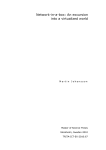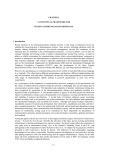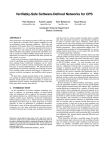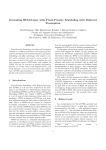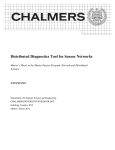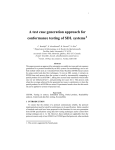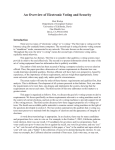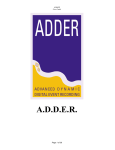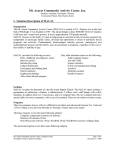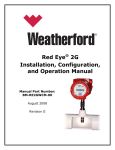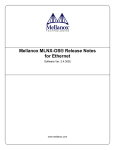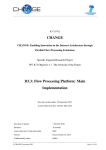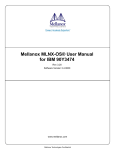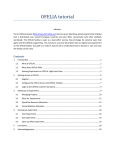Download Coping with Link Failures in Centralized Control Plane Architectures
Transcript
Coping with Link Failures in Centralized Control Plane Architectures Maulik Desai [email protected] Department of Electrical Engineering Columbia University New York, NY 10027 Abstract—Recently proposed SoftRouter and 4D network architectures recommend having the least amount of intelligence in the switches. They advocate transferring control plane functionalities to general-purpose servers that could govern these switches remotely. A link failure in such architectures could result into switches losing contact with the controller or even generating routing loops. These scenarios could generate a large amount of unnecessary traffic in the network. We study the implications of a failed link in such architectures. We develop an algorithm that would inform only the relevant switches to refrain from sending messages in the direction of the failed link, and yet have the minimum amount of intelligence on the switches. We implement our algorithm on a network formed by OpenFlow switches and evaluate its performance. Our experiments verify that the performance of our algorithm is dependent on the total number of flow-table entries in a switch. We also verify that by implementing our algorithm all the necessary switches are informed of the failed link significantly sooner than the controller identifies the failed link and sends out an update. Index Terms—Link failures, Centralized control plane I. I NTRODUCTION Some of the recent research efforts emphasize on maintaining a centralized control plane in a network, instead of having routers make their own control decisions. In such architectures routers could be replaced with the switches that would have the least amount of intelligence, and all the control plane functions of these switches could be handled by a centralized authority such as a general-purpose server. While a centralized control plane could help establish a firm grip over the network’s behavior, this new architecture also introduces a new set of problems. One such problem is link failures. SoftRouter [6], [8] and 4D [4] are two of the proposed centralized control plane architectures, in which a switch has to rely on a remotely connected controller to make all of its control decisions. In traditional networks, every time a link fails a router identifies the failure and establishes an alternate route. However, in SoftRouter/4D architectures even though a switch could identify the failed link, it has neither the intelligence nor the global knowledge to establish a new route. It must depend on the updates from the controller to establish an alternate route. Until a controller identifies a failed link and updates flow table entries in all the relevant switches, packets that are supposed to travel on the failed link will be dropped. c 978-1-4244-5489-1/10/$26.00 2010 IEEE Thyagarajan Nandagopal [email protected] Bell Laboratories Alcatel-Lucent Murray Hill, NJ 07974 Therefore, until a controller sends an update, it is important to prevent the traffic going towards the failed link to preserve the processing resources of the network. In many cases a group of switches could completely get disconnected from their controller due to a failed link, and start sending out messages to reach their controller. In such cases it is important to instruct these switches to stop their attempts to find a controller, since all their efforts are going in vain. In large networks different sets of switches may be controlled by different controllers. If a link fails in such scenarios and the controllers make conflicting decisions in establishing new routes, it could lead to forming routing loops in the network. Routing loops induce a large amount of unnecessary traffic in the network, hence it is important to take precautions to prevent any loops in the network that could be formed by a failed link. To avoid the problems created by a failed link it is important to come up with a way to inform all the relevant switches of this event, and ask them to refrain from sending messages in that direction. While flooding the news of a failed link could easily accomplish this objective, it disregards the idea of keeping the unnecessary network traffic to a minimum. Therefore, we devise a way such that only the necessary switches will be informed of the link failure. Furthermore, we accomplish this without violating the basic premises of maintaining the minimum amount of intelligence available on the switches. We implement our scheme in a network formed by OpenFlow [7] switches and verify that the news of the failed link reaches network switches a lot sooner than the controller can identify the failure and send out an update. OpenFlow switches are open source switches that could be controlled by a remote controller. Therefore, it is possible to create a SoftRouter/4D network architecture using these switches. They provide a great deal of flexibility in defining network flows, and it is quite easy to observe these flows. Therefore they are very useful in observing the performance of our scheme. The rest of the paper is organized as follows. In section II we provide an overview of SoftRouter and 4D architectures. We also give a small overview of OpenFlow switches in the same section. Section III elaborates on the problems introduced by link failures. In section IV we give a solution to overcome the problems introduced by link failures. Section V analyzes our algorithm and presents the results of our experiments. Finally, section VI presents the conclusion. II. R ELATED W ORK SoftRouter and 4D architectures are two of the proposed centralized control plane architectures. SoftRouter architecture was proposed by Bell Labs. While in existing networks a router’s control functions and packet forwarding functions are tightly interwined, SoftRouter architecture advocates separating both of them. Since the control functions run on every router, maintaining a large network is extremely complex and expensive. Authors of SoftRouters hope to gain some simplicity in a network by separating the control and packet forwarding functions of a router. Elements of a SoftRouter network could be classified as follows. • • • Forwarding Element (FE): FEs are basically switches that perform packet forwarding and switching functions. They have minimum amount of control functions running on them. Control Element (CE): CEs are general purpose servers, they are connected to multiple FEs and run the control plane functions on behalf of them. Network Element (NE): NE is a logical grouping of some CEs and a few FEs. It is suggested that by separating control and packet forwarding functions SoftRouter architecture could also increase reliability in a network. An IP router could have hundreds of thousands of lines of code. With such a high amount of software running on every router in the network, probability of the control plane functions making a mistake is very high. If control functions could be governed by a centralized authority (CE), and the packet forwarding functions could be given to the switches with little software on them (FE) , probability of a control plane error could be greatly reduced. Besides simplicity and increased reliability, authors of SoftRouter also make a case for scalability, control plane security, reduced cost, and ease of adding new functionality. 4D architecture is another proposed scheme whose design and benefits are similar to SoftRouter. Authors of 4D architecture suggest splitting a network into four logical planes. • • • Decision Plane: Decision plane makes all the decisions regarding network control. It is made up of multiple servers called decision elements. Dissemination Plane: Dissemination plane is responsible for efficient communication between the decision elements and network switches. Dissemination plane maintains separate paths for control information and regular data packets. It is more of a logical entity and may not be comprised of any physical element. Discovery Plane: Discovery plane is responsible for identifying physical components of a network such as switches. This plane is also a logical plane. • Data Plane: Data plane is controlled by decision plane, and it is primarily responsible for handling individual packets. Authors of 4D architecture indicate that this scheme could offer further robustness, increased security, more heterogeneity and a separate networking logic from distributed systems. Both SoftRouter and 4D architecture share one thing in common, that is they maintain a separate control plane from the data plane. Moreover, packet forwarding elements (switches) are controlled remotely by control elements that could be multiple hops away from the switches. While we develop a solution that will prevent unnecessary traffic from floating around in a network during an event of a link failure, it is important to test this solution too. However, most of the commercial switches are closed boxes, and hence they fail to give a good insight into network management. In recent years many academic researches have turn their attention to developing open platforms that could help researcher experiment with various networking protocols. Geni [1], XORP [5] and OpenFlow [7] are some of such efforts. To test our solution to overcome link failure problems, we use a network formed by OpenFlow switches. OpenFlow switches could be controlled by a remotely located controller, hence it is suitable for creating networks with a centralized control plane. OpenFlow switches allow maintaining multiple data paths in the same network such as production flows and research oriented flows. Furthermore, these switches easily allow network administrators to add, remove and monitor flows in the network. Each OpenFlow switch maintains a flow table. A flow table entry has three main parts [2]. • • • Header Fields: Table I shows a sample flow table header. In OpenFlow switches a flow could be defined according to the fields in this header. For example, a flow could be defined according to the ingress port, or it could be defined according to the destination’s IP address. A flow could also be defined as the combination of multiple header fields. The header fields that are defined as “ANY” or left blank in the flow table are considered to be wildcard entries. Counters: Counters maintain statistics for the switch. They keep count on how many packets are received, transmitted, dropped etc. Actions: If the header of a received packet matches with the header fields specified in a flow table entry, action defined in this field is applied to that packet. An action could be transmit the packet to a certain interface, drop or flood the packet etc. Once an OpenFlow switch receives a packet, this packet is matched against the flow table entries. If the packet matches with a flow table entry, action specified in that entry is applied to the packet. However, if a packet does not match any of the entries, it is transmitted to the controller through a secure channel. Secure channel is simply an interface that connects the OpenFlow switch to its controller. TABLE I F LOW TABLE ENTRY HEADER Ingress Port VLAN ID Ethernet Source Ethernet Destination Ethernet Type IP Source Ease of use and open source nature of OpenFlow switches make them very useful tools for experimenting with newly developed networking schemes. IP Destination IP Type TCP/UDP Source Port TCP/UDP Destination Port Link failures are quite common in large networks. Based on the topology and flow structure of a network, a failed link could have different kind of implications on a network. In this section we study the effects of a failed link on various networking scenarios. Naturally, it is unwise to have packets floating around in the network that are eventually going to be dropped. At the same time, since a large amount of controller’s resources are occupied in executing control plane functionality, it is imprudent to impose additional computational burden on the controller by asking it to manage the undelivered packets. The best option in this situation is to inform all the relevant switches in the network about the failed link, and ask them to refrain from sending messages to B that travel towards A, until the controller sends them an update. A. A simple link failure scenario B. Island III. L INK FAILURE I C 10.0.4.1 10.1.0.0/16 A H Controller 10.0.1.1 B C G F Fig. 1. B 10.0.3.1 D 10.0.5.1 E D A 10.0.2.1 Fig. 2. Formation of an island due to a failed link Controller A simple link failure scenario All the switches shown in figure 1 are controlled by a single controller. Furthermore, flows in these switches are configured in a manner that all the messages going towards 10.1.0.0/16 go through switches A and B. In regular network settings, if the link between A and B fails, node B will have enough intelligence to find another route for 10.1.0.0/16 traffic. However, in SoftRouter/4D architectures switches are not clever enough to divert the traffic and wait for some instructions from the controller. Since the controller may have the knowledge of the global topology it could do one of two things. The controller can recalculate an alternative path going towards 10.1.0.0/16 and it can either update the flow tables of all the switches in the network or it can simply instruct B to send these messages to A through C. However until the controller sends an update, all the switches in the network will keep sending their messages to B, and B will have to drop these packets. If the network is configured in a proper manner B can send these messages to the controller, and have the controller figure out what should be done with these undelivered packets. It is important for a switch in the network to maintain its connection with the controller. If a switch loses connection with the controller, often times it is possible to establish an alternative route. However, there are times when part of a network could completely get segregated from the rest of the network, and an island is formed. The switches that are part of this island do not have a way to reach their controller. Figure 2 depicts a scenario when a link failure could lead to the formation of an island. Switches B,C and D are connected to the controller through A. When the link between A and B fails, nodes B, C, D do not have a way to reach the controller. These three segregated switches form an island. As mentioned earlier, switches in SoftRouter/4D architectures do not possess much control plane functionality, hence losing contact with the controller could adversely affect the functionality of the network. Depending on the implementation of the network, whenever a switch loses contact with its controller, the switch or the controller (or both of them) may try to reach each other. However, whenever an island is formed, there is no way for the switches and the controller to establish a contact. Hence switch B will end up dropping all the packets from the messages that come from C and D and try to reach the controller. Thus, all the attempts by B, C, D to reach the controller result into unwanted and unnecessary traffic. Similarly switch A will also drop all the packets that come from the controller and try to reach B, C, D. For example, OpenFlow implementation of a switch offers two kinds of functionalities. • fail−closed: In fail−closed mode, whenever the connection between the switch and the controller fails, the switch does not take any actions, it simply waits for the controller to establish a new connection. • fail−open: In fail−open mode, the switch becomes proactive and tries to reach the controller periodically once it loses the connection with the switch. By default, the period between two such attempts increases exponentially, with the maximum wait period of 15 seconds. Switches B, C and D do not necessarily have the global knowledge of the network topology, hence they may not have the intelligence to avoid sending message towards the controller whenever an island is formed. However, it is possible for B to check whether all of its links are up and working. If B could inform its neighbors of the failed link, it is possible to avoid this unnecessary traffic. On the other hand, even though the controller could have the knowledge of the global topology, it will keep trying to reach the switches that belong to the island. It does not immediately know that the link between with A and B is broken. If A could inform the controller of the broken link, its attempt to reach the island could be prevented. C. Routing Loop In many cases link failure could lead to forming routing loops. Routing loops also adversely affect a system’s performance by increasing network traffic significantly. 2 B 10.0.3.1 3 1 1 2 Controller:I 10.0.1.1 1 1 A 10.0.2.1 Controller:II 10.0.5.1 3 2 1 2 3 C 10.0.4.1 Fig. 3. An example of routing loop caused by a failed link Figure 3 demonstrates a scenario where a link failure could result into routing loops. In this figure, switch A is controlled by Cotroller: I, and switches B,C are controlled by Controller: II. IP addresses of the switches and their interface names are labeled in the diagram. Let us assume that the flows in this network are defined according to destination IP addresses. Flow tables of switches A and B are shown in tables II and III. According to these flow tables, messages coming from A and going towards C have to go through switch B. TABLE II O RIGINAL F LOW TABLE FOR SWITCH : A (F IGURE 3) Destination’s IP Address 10.0.4.0/24 Action Forward to interface# 2 TABLE III O RIGINAL F LOW TABLE FOR SWITCH : B (F IGURE 3) Destination’s IP Address 10.0.4.0/24 Action Forward to interface# 1 However, the link between switches B and C fails and the controllers decide that the messages destined for C should go through switch A. While Controller: II successfully updates switch B’s flow table, switch A is not updated due to the delay in the network. Therefore, switch B’s flow table gets updated while A’s flow table remains unchanged as shown in IV and V. TABLE IV U NMODIFIED F LOW TABLE OF SWITCH : A (F IGURE 3) Destination’s IP Address 10.0.4.0/24 Action Forward to interface# 2 TABLE V U PDATED F LOW TABLE OF SWITCH : B (F IGURE 3) Destination’s IP Address 10.0.4.0/24 Action Forward to interface# 2 In this case, A will send all the messages going towards C to B, and B will send them back to A, and thus a routing loop is induced in the network. This situation could be prevented if B could inform A that the link between B and C has failed, and it will no longer be able to forward messages towards C. This process can be completed a lot sooner than the controllers could identify a failed link and update their respective switches, and hence the routing loops could be avoided. Considering the scenarios presented in the this section, it becomes necessary to come up with a scheme that would reduce the damage caused by a failed link. We outline basic requirements for such a scheme as follows. • In case of a link failure, all the switches that could send flows in the direction of the failed link should be informed of this event. • Link failure messages should not propagate in the network indefinitely, and unless required, these messages should not be flooded in the network. • The scheme should provide enough information to the network switches regarding the flows that are affected by the failed link. At the same time, it should make sure that the flows that are not affected by this event do not get modified. • The proposed scheme should not violate the basic premises of keeping the minimum amount of intelligence available at the switches IV. S OLUTION TO L INK FAILURES In this section we develop a solution to minimize the problems created by a failed link. In the solution we do not concern ourselves with how a controller learns about the broken link, and how it updates the flow table of network switches in order to accommodate the link failure. Our primary focus is to develop a solution that will inform the network switches to not send any flows that are supposed to go through the failed link, yet this solution will have to impose the least amount of computational burden on the network. A. A proper way to define a flow A good solution that could minimize the problems created by a failed link begins with properly defining flows in a network. Whenever a link fails in the network, our goal is to inform this event to all the switches that could send flows in the direction of the failed link. However, we have to make sure that these Link Failure Messages (LFM) do not get flooded in the entire network. Therefore, it is necessary for a switch to have the knowledge of where a flow is coming from. While switches in a centralized control plane architectures do not have the knowledge of the global topology, origin of a flow could be identified from a flow table entry. As mentioned earlier, in OpenFlow switches a flow could be defined by choosing any combination of eight header fields shown in table I. For example, if a flow is defined according to source’s and destination’s IP addresses, a switch could easily derive the origin of the flow and send a link failure message in that direction. However, in many cases this information may not be very useful. Let us consider following example. C 10.0.4.1 2 Controller 10.0.1.1 3 A 10.0.2.1 1 B 10.0.3.1 4 D 10.0.5.1 Fig. 4. An example of why source IP addresses do not necessarily indicate which direction a flow is coming from In figure 4 all the switches are connected to the same controller. Let us assume that the flows in this network are specified according to the source and destination IP addresses, and switch A’s flow table is described in table VI. TABLE VI F LOW TABLE OF SWITCH A (F IGURE 4) Source IP Address 10.0.5.0/24 10.0.3.0/24 Destination IP Address 10.0.3.0/24 10.0.4.0/24 Action Forward to interface# 1 Forward to interface# 2 In such a configuration, if the link between switches A and B breaks, switch A could look up its flow table and identify that all the flows that go to interface# 1 are coming from IP addresses 10.0.5.0/24. Unfortunately flow table of A does not specify which output port should be used to send link failure messages to the switches with IP addresses 10.0.5.0/24. Hence, specifying the source’s IP address is not necessarily useful. Similar argument could be made to justify that specifying the source’s MAC address may be helpful in identifying the origin of the flow, but it may not be too useful to forward link failure messages. If a flow definition includes ingress port of a flow as well, it is possible to send link failure messages to the switches from where the flows are coming in. An ingress port is the interface from where packets enter into a switch. In fact, once every switch in the network uses ingress port in the flow definition, LFM could be delivered to the every switch that could send flows in the direction of the failed link. Let us consider the same example shown in figure 4, however, this time flows are defined according to the ingress port and the destination’s IP address. The new flow table of switch A is shown in table VII. TABLE VII N EW FLOW TABLE OF SWITCH A (F IGURE 4) Ingress Port 4 1 Destination IP Address 10.0.3.0/24 10.0.4.0/24 Action Forward to interface# 1 Forward to interface# 2 With such a configuration, whenever the link between the switches A and B fails, switch A could look up its flow table, and identify that flows that are going towards the failed link come from interface# 4. Now all switch A has to do is to prepare a LFM, and send it out on interface#4. A switch located on the other end of that link will receive this LFM and stop sending messages that could go towards the failed link. Therefore, it is important to include ingress port in the definition of a flow. Whenever a switch sends out a LFM, it should include enough information in that message, so that the switch receiving this message could understand which flows should be prevented from going out. In the following section we specify the information that should be included in a LFM and how this information should be used to identify flows that could go towards the failed link. To maintain the simplicity in explaining, we split our scheme into two parts. (1) Computations that would be performed at the switch that experiences a link failure (2) Computations that would be performed at the switch that receives a LFM. B. Computations for the switch experiencing link failure Algorithm for the switch experiencing the link failure is relatively simple. Once a switch learns that one of its link is down, it identifies the network interface associated with that link, let us call this interface brokenInterface. Now the switch will look up its flow table and create a LFM for every input interface which brings in a flow that could be sent to brokenInterface. Structure of the LFM is show in table VIII. If txInterface is one of the interfaces where a LMF is sent out, this particular LFM will contain the definition of all the flows that come in from txInterface and go out from brokenInterface. Finally we modify the “Action” field of the flow table entries whose flow definitions are attached to LFMs. The new action will indicate that packets from these flows should be dropped. If the network is configured properly and the connection with the controller is not interrupted due to the failed link, packets from these flows could be diverted to the controller also. TABLE VIII L INK FAILURE MESSAGE STRUCTURE Source Address. Message ID Flow Definition Flow Count Flow Def.#1 ··· ··· Flow Def.#n E 10.0.6.1 2 Controller 10.0.1.1 C 10.0.2.1 3 A 10.0.3.1 1 B 10.0.4.1 D 10.0.5.1 4 F 10.0.7.1 Fig. 5. A figure demonstrating how to generate LFM Consider a topology shown in 5. Switch A’s flow table for this topology is shown in table IX. TABLE IX F LOW TABLE OF SWITCH A (F IGURE 5) Ingress Port 2 3 3 4 4 Destination IP Address 10.0.7.0/24 10.0.4.0/24 10.0.5.0/24 10.0.6.0/24 10.0.4.0/24 Forward Forward Forward Forward Forward Action to interface# to interface# to interface# to interface# to interface# 4 1 1 2 1 In this example when the link connecting A and B fails, switch A will look up its flow table and identify that it is receiving flows from interfaces 3 and 4 that will be sent out on interface# 1. Therefore A will create two LFMs, one for interface#3 and one for #4. Even though A is receiving a flow from interface#2, since this flow is not going out on interface#1, no LFM will be sent out through 2. Since there are two flows that come through interface#3 and go out from interface#1, LFM that goes out through 3, will have two flow definitions attached to it:10.0.4.0/24 and 10.0.5.0/24. There is just one flow that comes in from interface#4 and goes out from interface#1, hence LFM that goes out from 4 will have only one flow definition attached to it:10.0.4.0/24. It should be noted that even though we are using ingress port to define a flow, we do not have to attach that information to LFM, since ingress ports are switch specific. Finally we modify the “Action” field of the flow table, and new flow table of switch A would look like as shown in X. TABLE X N EW FLOW TABLE FOR SWITCH A (F IGURE 5) Ingress Port 2 3 3 4 4 Destination IP Address 10.0.7.0/24 10.0.4.0/24 10.0.5.0/24 10.0.6.0/24 10.0.4.0/24 Action Forward to interface# 4 Drop / Send to controller Drop / Send to controller Forward to interface# 2 Drop / Send to controller Various fields of LFM are described below. Source Address is the IP address of the switch that initiates the LFM. If a network supports MAC level routing instead of IP routing, IP address could be replaced with the MAC address of the source. Whichever switch receives LFM, uses this field to identify where this LFM is coming from. Message ID field helps make sure that the same LFM does not get forwarded multiple times by the same switch. If routes in a network are not configured correctly, the same LFM could come back at the same switch multiple times. If a switch receives two LFMs with the same message ID in a short time period, it disregards the second LFM. The switch that initiate a LFM, chooses a message ID randomly, and this value does not change as the message gets forwarded to the downstream switches. Once a switch receives a LFM, it stores it in its memory. The next time this switch receives a LFM it compares it with the stored value, and takes an action only if the message differs from the stored values. This way a switch does not propagate the same message multiple times. A stored LFM could be discarded after receiving an update from the controller or after a predefined time interval expires. Flow Definition field lists a subset of header fields shown in table I that make up the definition of a flow. While it is possible to attach all the eight fields in the LFM to define a flow, it could increase the length of the message. Also since not always all the fields are used to define a flow, it is unnecessary to add all eight header fields of a flow in LFM. Therefore flow definition field indicates which information is attached with this message. Each field in table I is given a numerical representation, and this value is included in the Flow Definition field of a LFM. For example, for the scenario presented in figure 5, whenever switch A creates a LFM, its Flow Definition field will have the numerical representation of “Destination IP Address” field. This way the switch receiving the LFM will know that the information attached with this message represent IP addresses of the destination. Flow Count indicates the total number of flow specifications that are attached with the LFM. For figure 5 the LFM that goes out of interface#3 will have a flow count of 2, and the LFM that goes out of interface#4 will have a flow count of 1. The rest of the fields provide the actual definition of the flows. Total number of such definitions attached to a LFM would be equal to the Flow Count value. Therefore in figure 5 when switch C receives a LFM from A, by looking at “Flow Definition” field it will know that the flow definitions are made up of Destination IP Address, and from Flow Count field it will learn that there are two flow definitions attached with this message. Since switch B also experiences a link failure, the same algorithm will also be run at switch B. Algorithm 1 gives the pseudo code for preparing and transmitting LFMs, as well as updating flow table entries. To update the flow table entry in a switch (line 3), the program may have to make system a call. Executing shell commands from the program may take longer. To inform all the switches about the link failure as soon as possible, updating flow table entries might be put off until all the LFMs are sent out. Algorithm 1 Algorithm for LFM initiator upon detecting a broken link on port brkPrt. FlowDict is a dictionary / hash table whose keys are the ingress ports that bring in the flows going towards brkPrt, and the values are the lists containing the definition of these flows. SendMsg(prt, msg) is a function that sends out a message (msg) through port (prt). 1: for each entry ∈ F lowT able do 2: if entry.inP ort = brkP rt then 3: entry.action ← drop 4: F lowDict[entry.inP ort].append(entry.f lowDef ) 5: end if 6: end for 7: for each key ∈ F lowDict.keys() do 8: msg.srcAddr ← Self IP/M AC Addr 9: msg.id ← RandomN umber 10: msg.f lowDef ← P redef ined f low def inition 11: msg.f lowCount ← length(F lowDict[key]) 12: msg.f lowList ← F lowDict[key] 13: SendM sg(key, msg) 14: end for C. Computations for the switch receiving a LFM Once a switch receives a LFM, it makes the note of the interface from where the message came in. Let us call this interface rxInterface. The switch will also detach the list of flow definitions attached with this LFM, let us call it flowList. Next, it will look up its flow table and try to locate ingress ports that bring in flows that match with the flows in flowList, and go out from rxInterface. A new LFM will be generated and sent out from each of these ingress ports. Whenever a switch generates a new LFM, the “Message ID” field of this new message remains the same as the “Message ID” of the original LFM. Naturally one could ask why do we have to create a new LFM every hop instead of forwarding the same LFM. Following example helps answer this question. 10.1.0.0/16 Controller 1 E 2 10.1.0.0/16 10.1.1.0/24 1 C B 2 A 3 10.1.2.0/24 D Fig. 6. An example showing why a new LFM should be created every hop TABLE XI F LOW TABLE OF SWITCH C (F IGURE 6) Ingress Port 1 1 Destination IP Address 10.1.1.0/24 10.1.2.0/24 Action Forward to interface# 2 Forward to interface# 3 In figure 6 switch B sends all of its 10.1.0.0/16 traffic to switch A. Whenever the link between the switches A and B breaks, B will inform switch C to not send any 10.1.0.0/16 traffic in its direction. If switch C forwards the same LFM to E, switch E will simply stop sending all its 10.1.0.0/16 traffic to C, even though C is completely capable of accepting and forwarding part of 10.1.0.0/16 traffic. Therefore whenever switch C receives a LFM from switch B, it will make a note that this LFM is received on interface#2 (rxInterface). It will notice that there is just one flow table entry that sends out flow on rxInterface. Furthermore, flow definition of this entry matches with the definition attached with the received LFM. Therefore, switch C will send out a new LFM to the ingress port of this entry, which is interface#1. The flow definition attached to this new LFM would be the definition available in the flow table table entry (10.1.1.0./24) and not the definition attached with the received LFM. Whenever, switch E will receive this LFM from C, it will learn that it should not send 10.1.1.0/24 traffic to switch C. While the next step is to modified the “Action” field of the affected flow table entries, this part is a bit tricky as well. Many times a received LFM may contain flow definitions that represent only a subset of flows defined in a flow table entry. In such cases it is important to split a flow table entry into two, before modifying its “Action” field. For the topology shown in figure 6, let us assume that flow table of switch E is as shown in table XII. TABLE XII F LOW TABLE OF SWITCH E (F IGURE 6) Ingress Port 1 Destination IP Address 10.1.0.0/16 Action Forward to interface# 2 When switch E receives a LFM from C, this message will indicate to refrain from sending 10.1.1.0/24 traffic towards C. However, E does not have any flow table entry that exactly matches with 10.1.1.0/24. If it modifies the action field of 10.1.0.0/16 entry, it will not be able to send any messages to C. Therefore in this case switch E will split this flow table entry into two. While the original entry will remain intact, the new entry’s action field will be changed to “Drop packet” or “Send packet to the Controller”. The new flow table for switch E will look like as shown in XIII. TABLE XIII N EW FLOW TABLE FOR SWITCH E (F IGURE 6) Ingress Port 1 1 Destination IP Address 10.1.1.0/24 10.1.0.0/16 Action Drop / Send to Controller Forward to interface# 2 Now if switch E receives a packet going towards IP address 10.1.2.5, this packet will match with the second flow table entry and hence it will be sent out on interface#2. On the other hand if E receives a packet going towards 10.1.1.5 on interface#1, this packet will match with both the flow table entries, however, most of the switches are configured such that when a flow packet matches with multiple entries, only the entry with the highest priority will be considered. Therefore, in this particular case the packets going towards 10.1.1.5 will be dropped. While one could come up with cases where instead of splitting a flow table entry, we have to merge or even delete some of the entries. However, we refrain from doing so, since a switch does not possess the global knowledge of the topology. This task is left for the controller to complete. This LFM forwarding procedure could continue until the LFM reaches an end host. Since LFM is forwarded only to the ingress ports which could potentially bring in packets going towards the failed link, a LFM will only reach the switches that could send a flow in the direction of the failed link. Therefore only the relevant switches are informed about the link failure, and the LFM does not go to the switches that have no use of it. Algorithm 2 gives the pseudo code for a switch that receives a LFM and verifies that its message ID is not one of the stored message IDs. Finally, we should mention that although we utilize port numbers to receive and forward messages, if a system is using DynaBind or ForCES [8] algorithms in a SoftRouter architecture, switches may have the knowledge of their next hop neighbors. If a system administrator prefers dealing with IP addresses instead of port numbers, our algorithm is still applicable in those scenarios by replacing forwarding port numbers with next hop neighbor IP address. D. Importance of specifying ingress port in the flow definition While so far we have been emphasizing on specifying ingress port with every flow definition, in this section we explain how much benefit we can achieve by doing so. If a switch has a lot of interfaces attached to it, it is not necessary that all these interfaces bring in the flows that could Algorithm 2 Algorithm for a downstream switch receiving lfm on brkPrt. FlowDict is a dictionary / hash table whose keys are the ingress ports that bring in the flows going towards brkPrt, and the values are the lists containing the definition of these flows. SendMsg(prt, msg) is a function that sends out a message (msg) through port (prt). splitEntry(flow) creates a new flow table entry whose flow definition is flow, and action is drop packet. The original flow table entry remains intact. 1: for each entry ∈ F lowT able do 2: if entry.inP ort = brkP rt then 3: prt ← entry.inP ort 4: for each f low ∈ lf m.f lowList do 5: if f low ⊇ entry.f lowDef then 6: entry.action ← drop 7: F lowDict[prt].append(entry.f lowDef ) 8: else if f low ⊂ entry.f lowDef then 9: splitEntry(f low) 10: F lowDict[prt].append(f low) 11: end if 12: end for 13: end if 14: end for 15: for each key ∈ F lowDict.keys() do 16: msg.srcAddr ← Self IP/M AC Addr 17: msg.id ← lf m.id 18: msg.f lowDef ← P redef ined f low def inition 19: msg.f lowCount ← length(F lowDict[key]) 20: msg.f lowList ← F lowDict[key] 21: SendM sg(key, msg) 22: end for go towards the failed link. Therefore, it is not necessary to send out LFMs on all these interfaces. B Controller D A F C G E Fig. 7. Specifying ingress port will be the most helpful in the topology that is similar to a perfect graph In figure 7 switches A through F are connected to each other in a manner such that their topology will form a perfect graph. Furthermore, let’s assume that flow tables of switches A through E are configured such that switch G is only two hops away from these switches. In other words if switch A through E have a flow that goes to G, this flow will directly go to F, and from F it will be delivered to G. Let us also assume that these switches do not have an ingress port specified with their flow table entries. Therefore, these switches will have to flood LFMs in the network in order to spread the news of a broken link. If the link between the switches F and G breaks, F will generate a LFM and send it out on rest of its five interfaces. Switches A through E will receive these messages, and forward them to rest of their four interfaces (all interfaces except for the one connected to the switch F). For example when switch A receives a LFM from F, it will forward its own LFM to the switches B,C,D and E. These switches will learn that the message coming from A has the same “Message ID” as the message that came from F. Therefore these switches will disregard the LFM that came from A. Thus, if we do not specify an ingress port, instead of sending 5 messages from F, we end up sending 25 messages to spread the news of the failed link (5 from F, and 4 from A through E). Controller A B C D E F G Fig. 8. Specifying ingress port could be the least helpful in a chain topology On the other hand specifying the ingress port could be the least helpful in a chain topology as shown in figure 8. In such a case if switch A has a flow for the switch G, it will go through switches B to F, before it reaches G. Therefore, whenever the link connecting F and G break, an LFM will have to go through all the switches to reach A, which is similar to flooding. However, in the most of the cases a network could be much more complex than a simple chain topology, hence specifying an ingress port could lead to a huge advantage in the scenarios like link failure. E. Flow tables without ingress ports Sometimes in existing networks it may not be possible to specify ingress ports for the flow table entries in all the switches. In such a case we may have to flood LFM to all the switches in the network. However, flooding a message could increase the risk of a message floating around in the network indefinitely. In such a scenario it is advisable to include a “Hop count” or “Time to live” field in the LFM. These value are included by the switch that initiates the LFM. The value of “Hop count” could be an integer value, that would decrease by one every hop as the message gets forwarded. A switch could stop forwarding a message once “Hop count” indicates 0. The other option is to include a “Time to live” value, which contains a time stamp. A switch could stop forwarding a LFM once the “Time to live” expires. “Hop count” and “Time to live” values have to be chosen carefully. If these values are too small and the size of the network is too large, a LFM may not reach all the switches that should receive this message. If these values are too big and the size of the network is too small, a LFM may have to travel a large portion of the network before a switch identifies the previously recorded “Message ID” and stops forwarding this LFM. V. P ERFORMANCE A NALYSIS While our algorithm is very simple, it is necessary to check that it is able to send LFM to all the necessary switches in a very short time period. To test the performance of our algorithm and give the proof of the concept that LFM will indeed be delivered to all the relevant switches in a small period of time, we set up a small network of kernel−based OpenFlow switches. These switches run the solution we developed in section IV. The switches are installed on virtual machines that run on Debian Lenny linux. The virtual machines are connected to each other such that a controller, six OpenFlow switches and an end−host form a chain topology as shown in figure 8. These virtual machines are assigned relatively low system resources. All eight virtual machines share a 2.6 GHz processor, with only 64MB of RAM assigned to each of them. Flows in this network are defined according to the destination’s IP address and ingress port. Each switch’s flow table will have entries that specify how to send flows to every other switch as well as the end−host. We choose this topology to test the performance since once we break the link between the switch F and end−host G, every switch in the network will have to be informed of this event, since all of them have a flow table entry that specifies a path to the end−host G. Unfortunately these virtual machines are not very well time synchronized [3], which makes it difficult to calculate total amount of time taken to reach all the switches. We calculate the time difference between the event of receiving a LFM and sending out a newly prepared LFM to a downstream switch for the chain topology. For switch F, total processing time taken is the time between identifying a failed link and sending out LFM to a downstream switch. TABLE XIV T IME DIFFERENCE BETWEEN THE EVENTS OF RECEIVING A LFM AND SENDING OUT A NEW LFM ( FIGURE 8). T IME SHOWN IN MILLISECONDS . Switch Processing Time (mSec) A 43 B 66 C 44 D 43 E 152 F 46 While we do not have the information of the time taken between transmitting and receiving LFMs, this time is negligible. If we ignore it, total time taken between F identifying a failed link and A sending out last LFM would be the sum off all the processing times, which is 394 mSec. Depending on implementation, the time between controller’s connectivity probe could vary between tens of seconds to a few hundred seconds. Compared to that, the total time taken to send LFM to every switch is quite negligible. Total time taken to notify all the switches may depend on a few factors. Naturally if a network has a lot of switches that send flows towards the failed link, it will take longer to send LFM to all of them. Another important factor is the total number of flow table entries in a switch. Clearly, larger the number of flow table entries, longer it takes to search for the flows that go towards the failed link. To understand how a flow table entry could affect the processing time, we add multiple flow table entries to switch F, and calculate the time it takes to send out a LFM to E. Since total time taken to prepare and transmit a LFM could vary depending on the load on the processor, the results shown in figure 9 are the averages of one hundred runs. Processing time Vs Flow table entries 105 y = 0.11*x + 75 Processing time (milliseconds) 100 95 90 85 80 50 100 Fig. 9. 150 Flow table entries 200 250 Processing time Vs Flow table entries From the algorithms presented in section IV it was clear that processing time may increase with the flow table entries. However, figure 9 shows that increment in processing time is rather too small. Adding a flow table entry could only increase processing time by approximately 0.1 millisecond, on the switches with scarcity of computational resources. Total number of flow definitions included in a LFM may also affect the overall process time. If a LFM contains a lot of flow definition, naturally it will take longer to scan flow table and look for the entries that match with the definitions given in LFM. Finally, if a switch has a lot of ingress ports that bring in flows going towards the broken link, this switch will have to send LFMs through all those ports. Fortunately overhead of sending a message out through a port is very low. Moreover, if switches in a network have a lot of interfaces, in a highly connected network, we may not have to transmit LFMs for several hops to reach all the necessary switches. VI. C ONCLUSION In centralized control plane architectures where a controller could be located multiple hops away from a switch, an event like link failure could create many problems. We studied these problems, and proposed a solution that will keep unnecessary network traffic to a minimum in such an event. Our solution informs all the relevant network switches to refrain from sending traffic towards the failed link without flooding. The simplicity of algorithm helps maintain the basic premises of keeping the minimum intelligence available at the network switches. Finally, we also make sure that all the relevant switches are informed of the failed link significantly sooner than a controller learns about this event and sends out an update. R EFERENCES [1] Global environment for network innovations. In http://geni.net. [2] Openflow switch specification. In www.openflowswitch.org/ documents/openflow-spec-v0.8.9.pdf. [3] Virtualbox end user manual. In http://www.virtualbox.org. [4] A Greenberg, G Hjalmtysson, D A Maltz, A Myers, J Rexford, G Xie, H Yan, J Zhan, and H Zhang. A clean slate 4d approach to network control and management. In In SIGCOMM CCR, 2005. [5] Mark Handley, Orion Hodson, and Eddie Kohler. Xorp: An open platform for network research. In ACM SIGCOMM Computer Communication Review, pages 53–57, 2002. [6] T V Lakshman, T Nandagopal, R Ramjee, K Sabnani, and T Woo. The softrouter architecture. In In HotNets-III, 2004. [7] Nick McKeown, Tom Anderson, Hari Balakrishnan, Guru Parulkar, Larry Peterson, Jennifer Rexford, Scott Shenker, and Jonathan Turner. Openflow: enabling innovation in campus networks. SIGCOMM Comput. Commun. Rev., 38(2):69–74, 2008. [8] Ramachandran Ramjee, Furquan Ansari, Martin Havemann, T. V. Lakshman, Thyagarajan Nandagopal, Krishan K. Sabnani, and Thomas Y. C. Woo. Separating control software from routers. In COMSWARE. IEEE, 2006.













